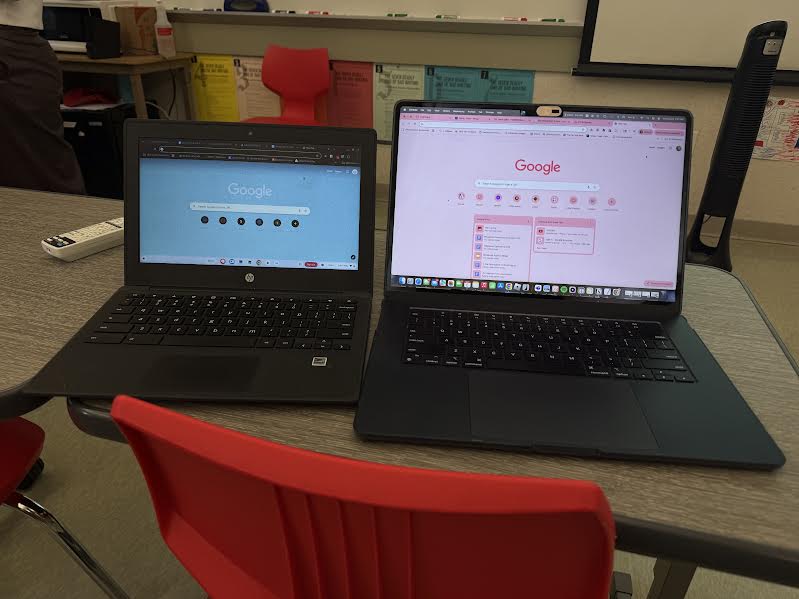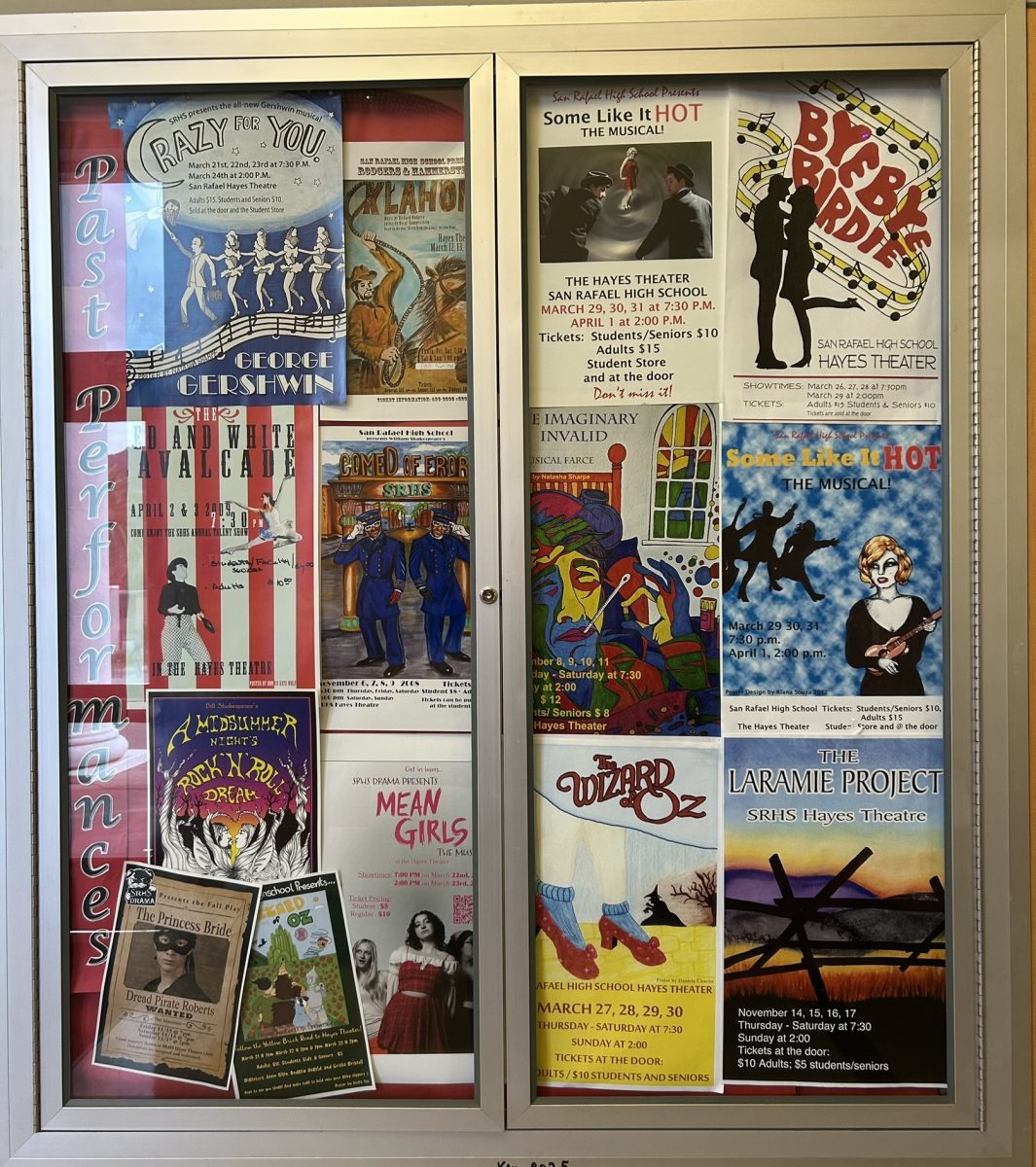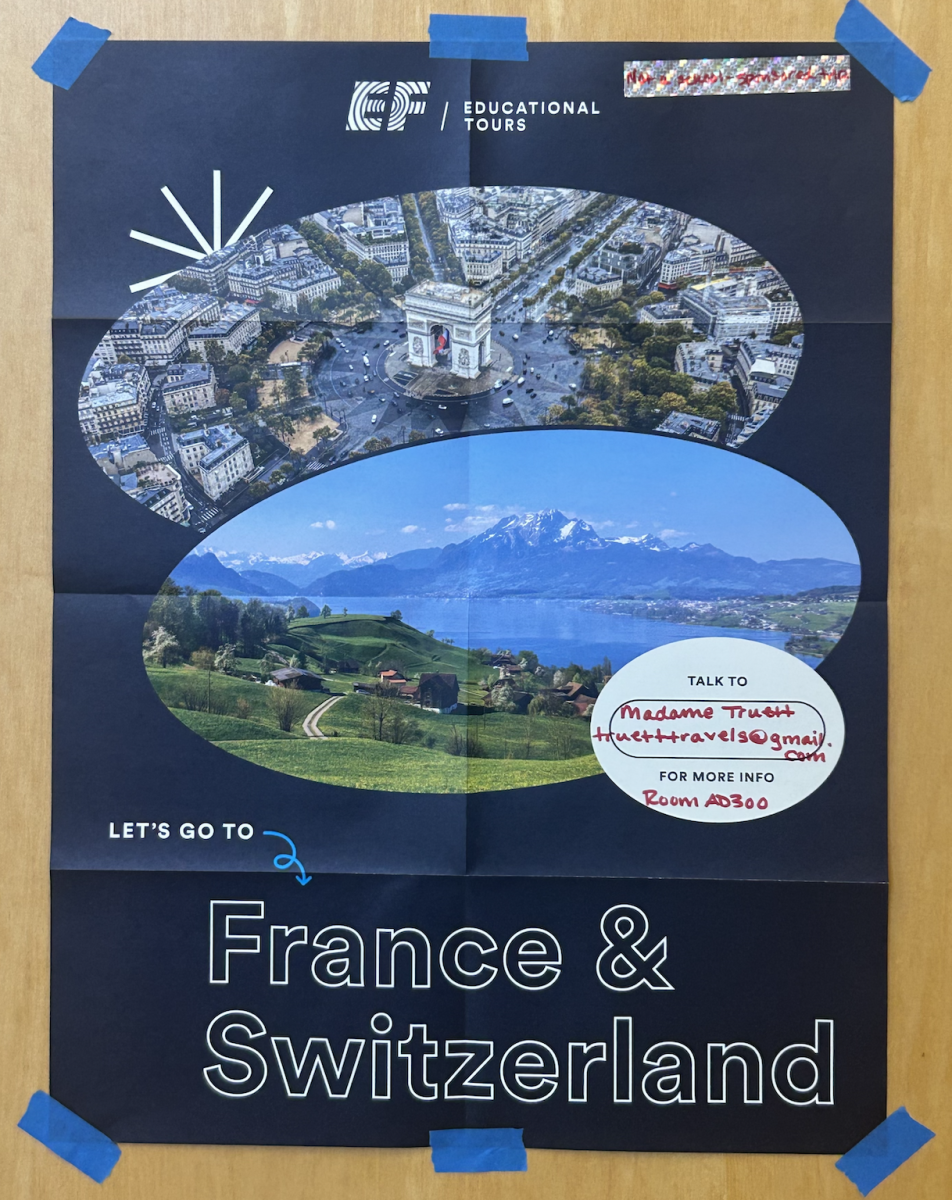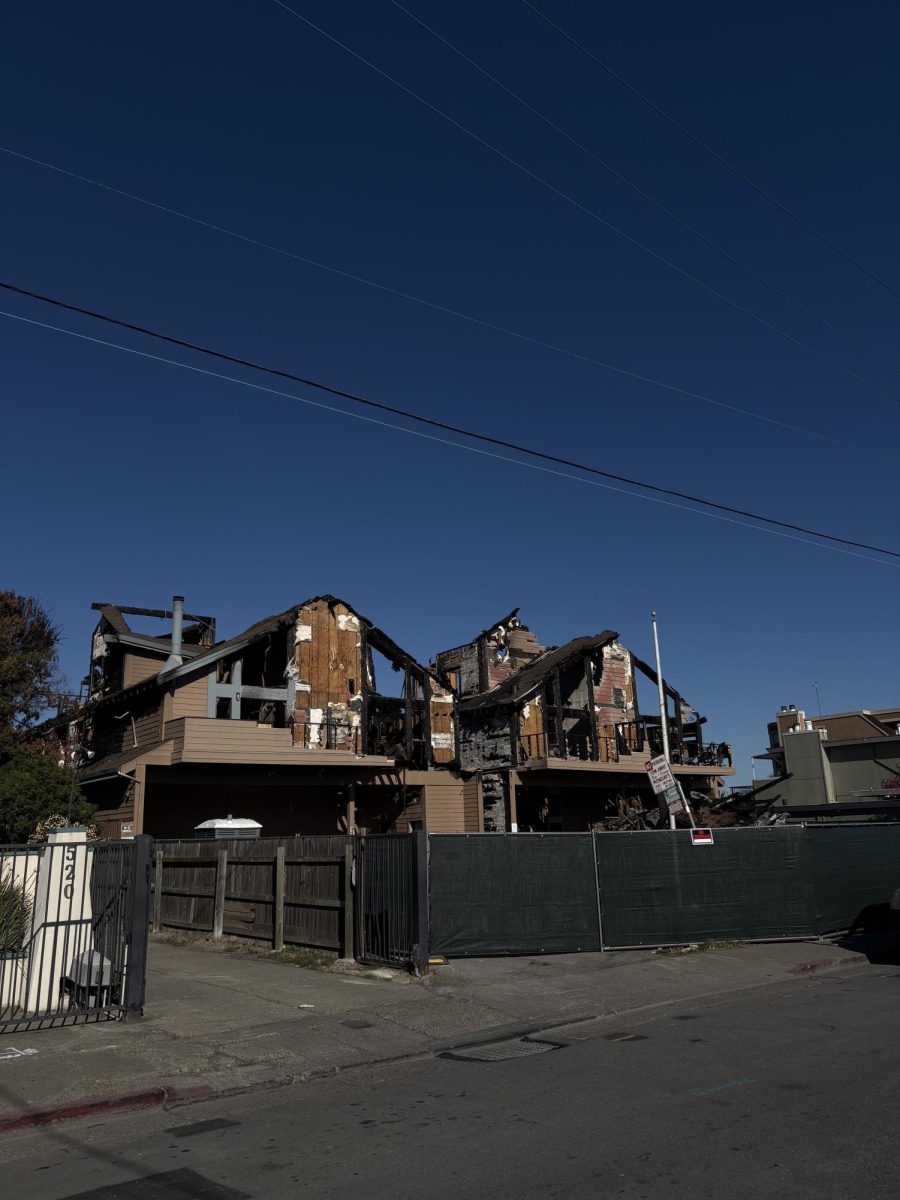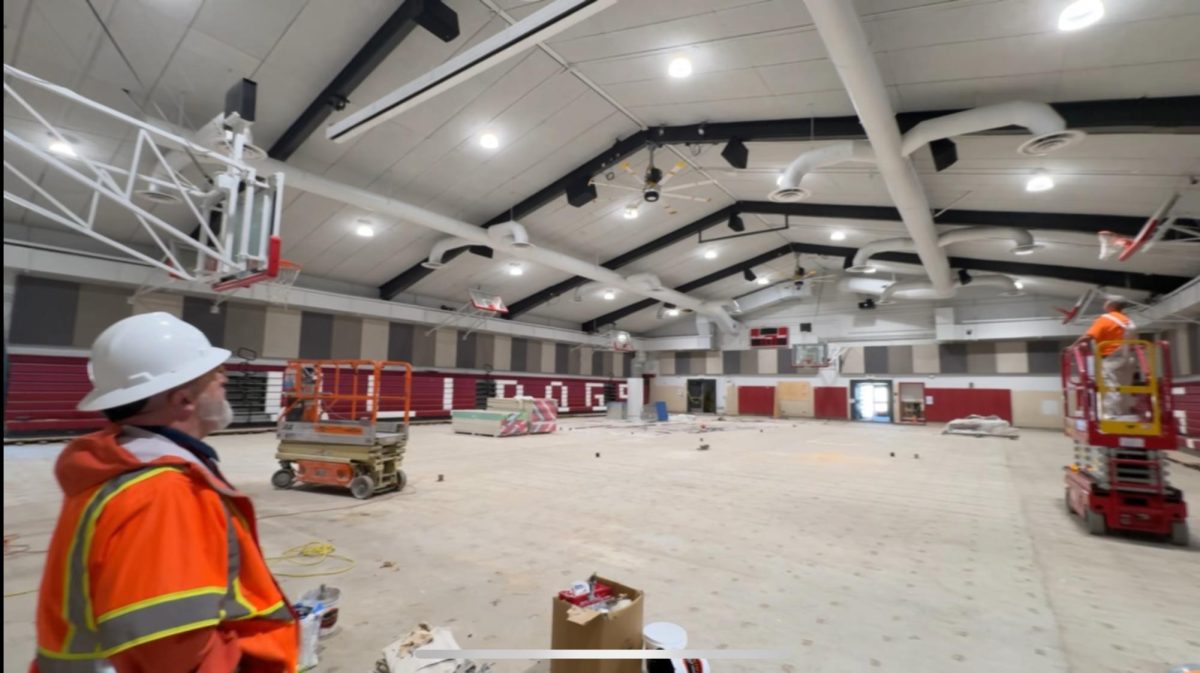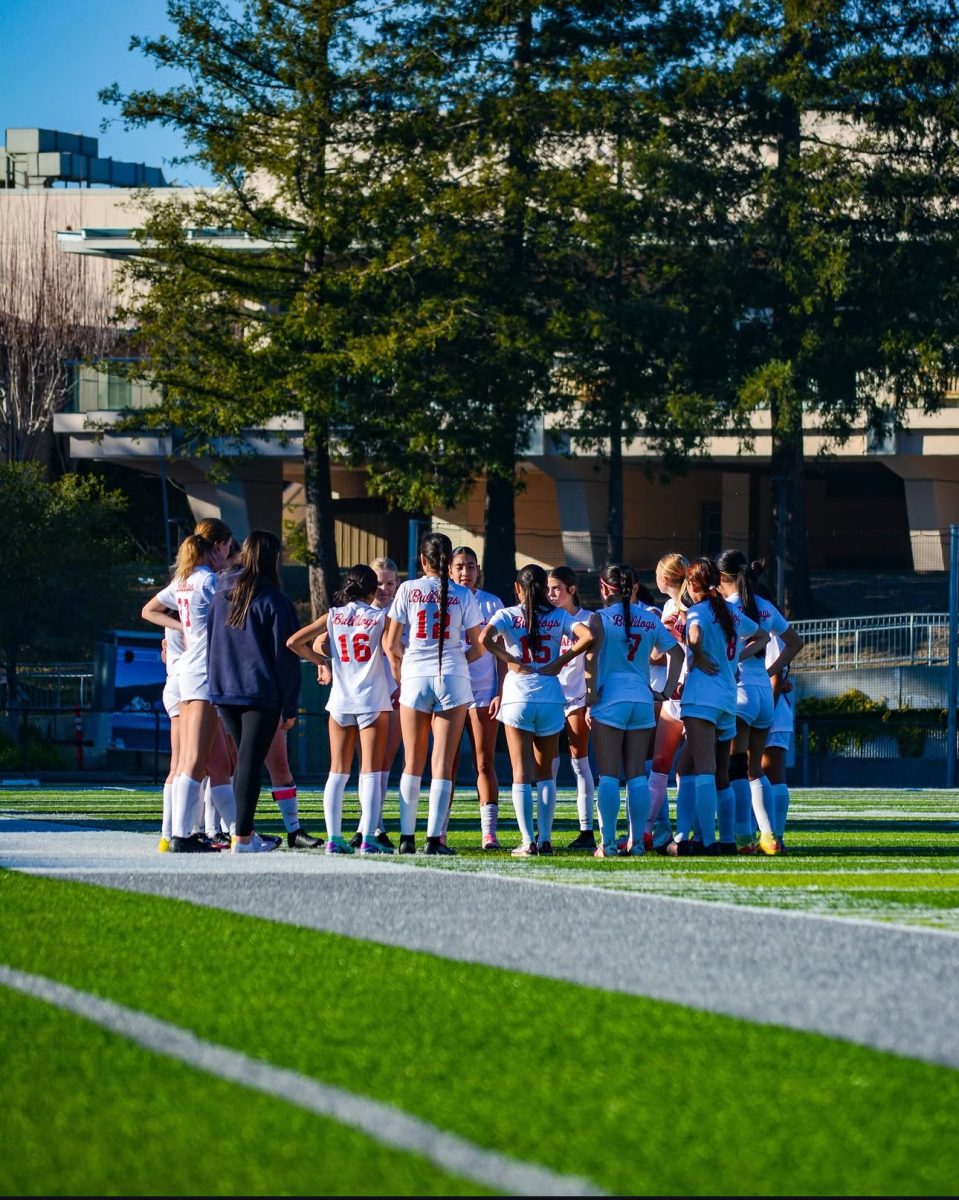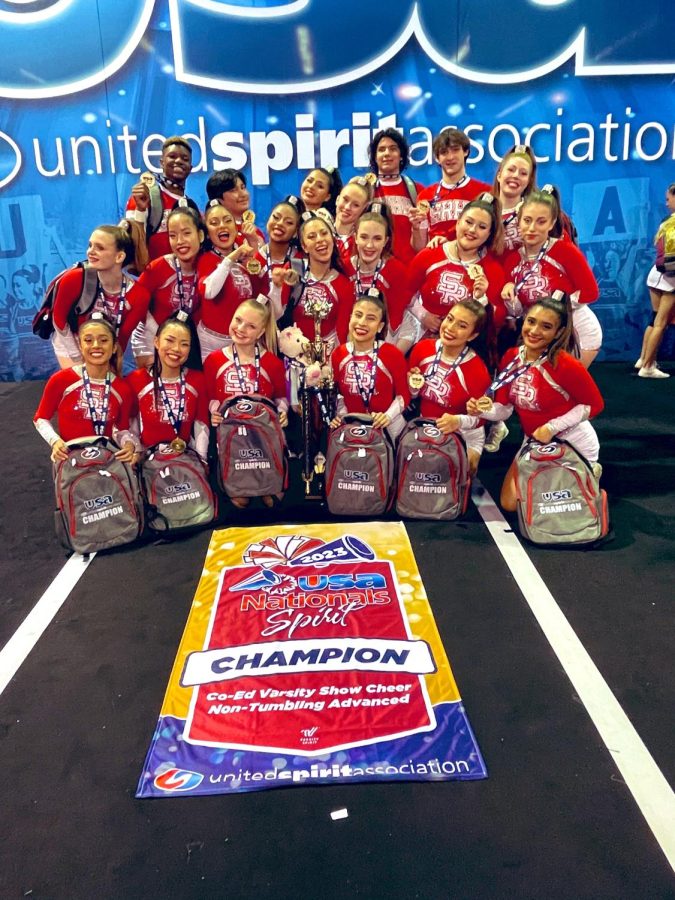SRHS Varsity Cheer Team Overcomes Adversity to Take Home Another National Title (TRANSLATED INTO SPANISH)
April 17, 2023
San Rafael High’s very own co-ed varsity cheer team recently took home a national title at the 2023 USA Spirit Nationals in Anaheim, California on February 24th and 25th. The team competed in the non-tumbling advanced division, making it through the preliminary round on day one and seizing gold in the finals on day two.
“It was a great end to the season,” says Sophie Loder, an SRHS senior and member of the team. This is Loder’s fourth year in the cheer program and her second on varsity.
The victory marks the fifth national championship earned by the varsity team, and the seventh for SR’s cheer program overall. The team’s performance was especially impressive because they not only earned a victory, but they also hit a perfect routine, a challenging feat in the world of cheer.
For head coach Shawna Hoch the most exciting part was not the victory or the trophy, but rather seeing her cheerleaders execute their routine in the way they had hoped to all season. “It was a beautiful thing [and] it was just a magical moment for everybody,” she says.
Nationals came at the end of a long competition season for the Bulldogs, including three USA Spirit regional competitions and one state competition, the CIF Regional Cheer Invitational. Although the team took first at all three regional competitions and second at state, their road to victory was not as smooth as their success might suggest.
“A lot more goes in than people think,” says Loder. “We’re pretty much working on the same routine from September to February.”
Unlike other sports, cheerleading is unique because everything revolves around just one routine. Hoch explains, “We don’t have any timeouts, we don’t have a bench, there’s no subs. You can’t pull someone out if they’re not doing well in that 2 minutes and 30 seconds.”
An important milestone during a cheer team’s season is when they hit a full-out, or perfors their routine completely, the way they would at a competition. This year, the Bulldogs did not hit their first full-out until late October, roughly a month before their first competition and later than they would have liked.
Loder noticed that the team was hitting their routine much less consistently than they had been the previous year. While they managed to pull things together for their first competition, at their second competition they had a fall.
Even though the judges factored in the difficulty of their routine and they still won, the team was demoralized by the mistake, as Loder tells it. “It was kind of like a wake-up call for everyone,” she says. “You don’t really feel good about winning when you have a fall.”
According to Hoch, this season was uniquely challenging for several reasons, the first being that many of the athletes on the team were either new to co-ed or new to cheer completely. This year’s team was almost half underclassmen, a significant shift from last season’s team of strictly juniors and seniors. The team also struggled with high turnover, losing around seven or eight athletes over the course of the season for various reasons, including poor grades and injury.
“We were kind of starting over,” explains Hoch. “[The cheerleaders] had a large learning curve ahead of them, but they worked really hard.”
Hard work from the players is not the only thing that contributes to the team’s success, though. The coaching staff play an instrumental role in driving the cheer program. All of the assistant coaches are actually alumni of the program themselves, a fact that Hoch prides herself on. It’s rare to see such consistency from coaches in cheerleading because the long season lends itself to high turnover.
Hoch herself has worked tirelessly to build the program from the ground up. When she first began coaching at San Rafael 16 years ago, the team had about 10 students and was mostly a dance team. She built the team’s skills over time, gradually introducing stunts, more complicated skills that involve lifting athletes into the air.
Last year, Hoch was recognized for her work by the California Coaches Association (CCA), who named her the first Competitive Cheer Coach of the Year. The CCA was established in 1957 and has been recognizing coaches in a variety of sports for many years. However, last year was the first time that a cheer coach received a Coach of the Year award. It was a win not only for Hoch and the SRHS cheer program, but for the sport as a whole.
“To be able to be not only selected to receive that award, but to be the first person who was selected to receive that award, was really special and something I will never forget,” says Hoch.
Hoch attributes her success to a key lesson she learned as she was building the program. At first, she was consumed with safety. She was hesitant to try more difficult stunts because they came with a higher risk level. Eventually, she realized her fear was holding the athletes back from maximizing their potential.
Once she stopped placing limits on the athletes, and instead focused on creating a safe space for them to try new things, “it really changed the way that the program was able to compete,” says Hoch.
As the success of the program grew, so did its size. In the years leading up to 2020, the team had 80 to 90 kids showing up for try-outs. Hoch says this is “huge” considering the size of the SRHS student body. This allowed the program to have 50 to 60 cheerleaders on the sidelines at games and participating in competitions. However, the COVID-19 pandemic quickly brought a halt to this growth.
“Kids were disengaged and weren’t really even able to understand what cheerleading at San Rafael High School was,” says Hoch. When the pandemic made close contact akin to a death sentence, high-contact sports such as cheer were at a major loss. Even when the team could finally trade their virtual practices for in-person ones, athletic restrictions remained strict and they were not able to cheer on the sidelines at any other athletic events.
Despite the set-backs the pandemic has caused, this season has brought with it a new chance for growth. Hoch says that the team this year is starting to look a bit more like the pre-pandemic days, and next season she is hoping for even more, or “60 to 70 kids at tryouts at least.”
The SRHS cheer program is rebuilding, and the win at nationals proves it. The struggles that the team had to face only serve to make their success taste even sweeter.
“I feel really accomplished,” says Belen Coronado, a sophomore and member of the team. It is her first year on varsity, but her second year in the cheer program. She says that the win is “relieving” after a long season of hard work.
Loder adds, “I think it made it so much better that we went through so much as a team.”
Translation by Matteo Diaz:
Nota del Autor/Traductor: Las palabras “cheerleading” y “varsity” no se traducen muy bien al español porque son exclusivas de la cultura estadounidense. Cabe señalar que en este artículo uso “animación” para significar “cheerleading” y “universitario” para significar “varsity”.
El propio equipo mixto de animadores universitarios de la Escuela Secundaria San Rafael recientemente ganó un título nacional en los Nacionales de Espíritu USA 2023 en Anaheim, California, el 24 y 25 de febrero. El equipo compitió en la división avanzada sin volteretas, superando la ronda preliminar el primer día y ganando el oro en la final el segundo día.
“Fue un gran final de temporada,” dice Sophie Loder, un estudiante de grado doce de SRHS y un miembro del equipo. Este es el cuarto año de Loder en el programa de animación y su segundo en el equipo universitario.
La victoria marca el quinto campeonato nacional obtenido por el equipo universitario y el séptimo para el programa de animación de SR en general. La actuación del equipo fue especialmente impresionante porque no solo obtuvieron una victoria, sino que también lograron una rutina perfecta, una hazaña desafiante en el mundo de la animación.
Para la entrenadora principal Shawna Hoch, la parte más emocionante no fue la victoria o el trofeo, sino ver a sus animadores ejecutar su rutina de la manera que esperaban durante toda la temporada. “Fue algo hermoso [y] fue simplemente un momento mágico para todos,” dice ella.
Los Nacionales llegaron al final de una larga temporada de competencia para los Bulldogs, incluidas tres competencias regionales de Espíritu USA y una competencia estatal, el CIF Invitacional Regional de Animación. Aunque el equipo obtuvo el primer lugar en las tres competencias regionales y el segundo en el estado, su camino hacia la victoria no fue tan fácil como su éxito podría sugerir.
“Entra mucho más de lo que la gente piensa,” dice Loder. “Prácticamente estamos trabajando en la misma rutina de septiembre a febrero.”
A diferencia de otros deportes, la animación es única porque todo gira en torno a una sola rutina. Hoch explica, “No tenemos tiempos muertos, no tenemos banco, no hay suplentes. No puedes sacar a alguien si no lo está haciendo bien en esos 2 minutos y 30 segundos.”
Un hito importante durante la temporada de un equipo de animacíon es cuando logran un “full-out”, o realizan su rutina completa, como lo harían en una competencia. Este año, los Bulldogs no lograron su primer “full-out” hasta finales de octubre, aproximadamente un mes antes de su primera competencia y más tarde de lo que les hubiera gustado.
Loder notó que el equipo estaba cumpliendo con su rutina de manera mucho menos consistente que el año anterior. Si bien lograron arreglar las cosas para su primera competencia, en su segunda competencia tuvieron una caída.
A pesar de que los jueces tuvieron en cuenta la dificultad de su rutina y aún así ganaron, el equipo estaba desmoralizado por el error, como cuenta Loder. “Fue como una especie de llamada de atención para todos,” dice ella. “Realmente no te sientes bien por ganar cuando tienes una caída.”
Según Hoch, esta temporada fue excepcionalmente desafiante por varias razones, la primera es que muchos de los atletas del equipo eran nuevos en el equipo mixto o completamente nuevos en la animación. El equipo de este año era casi la mitad de estudiantes del grado noveno o décimo, un cambio significativo con respecto al equipo de la temporada pasada de estrictamente estudiantes de grado once y doce. El equipo también luchó con un alto recambio de atletas, perdiendo alrededor de siete u ocho atletas en el transcurso de la temporada por varias razones, incluidas malas calificaciones y lesiones.
“Estábamos empezando de nuevo,” explica Hoch. “[Los animadores] tenían una gran curva de aprendizaje por delante, pero trabajaron muy duro.”
Sin embargo, el trabajo duro de los jugadores no es lo único que contribuye al éxito del equipo. El cuerpo técnico juega un papel fundamental en la conducción del programa de animación. Todos los entrenadores asistentes son en realidad ex alumnos del programa, un hecho del que Hoch se enorgullece. Es raro ver tal consistencia de los entrenadores en la animación porque la larga temporada se presta a una alta recambio.
Hoch misma ha trabajado incansablemente para construir el programa desde cero. Cuando comenzó a entrenar en San Rafael hace 16 años, el equipo tenía alrededor de 10 estudiantes y era principalmente un equipo de baile. Ella desarrolló las habilidades del equipo con el tiempo, introduciendo gradualmente acrobacias, habilidades más complicadas que involucran levantar atletas en el aire.
El año pasado, Hoch fue reconocida por su trabajo por la Asociación de Entrenadores de California (CCA), quien la nombró la primera Entrenadora de Animación Competitiva del Año. La CCA se estableció en 1957 y ha estado reconociendo a los entrenadores en una variedad de deportes durante muchos años. Sin embargo, el año pasado fue la primera vez que un entrenador de animación recibió un premio de Entrenador del Año. Fue una victoria no solo para Hoch y el programa de animación de SRHS, sino para el deporte en general.
“Poder no solo ser seleccionado para recibir ese premio, sino ser la primera persona seleccionada para recibir ese premio, fue realmente especial y algo que nunca olvidaré,” dice Hoch.
Hoch atribuye su éxito a una lección clave que aprendió mientras creaba el programa. Al principio, estaba consumida por la seguridad. Dudaba en probar acrobacias más difíciles porque venían con un nivel de riesgo más alto. Finalmente, se dio cuenta de que su miedo impedía que los atletas maximizaran su potencial.
Una vez que dejó de poner límites a los atletas y, en cambio, se centró en crear un espacio seguro para que probaran cosas nuevas, “realmente cambió la forma en que el programa podía competir,” dice Hoch.
A medida que crecía el éxito del programa, también lo hacía su tamaño. En los años previos a 2020, el equipo tuvo entre 80 y 90 niños que se presentaron a las pruebas. Hoch dice que esto es “enorme” considerando el tamaño del cuerpo estudiantil de SRHS. Esto permitió que el programa tuviera de 50 a 60 animadores al margen en los juegos y participando en competencias. Sin embargo, la pandemia de COVID-19 detuvo rápidamente este crecimiento.
“Los niños estaban desconectados y ni siquiera eran capaces de entender realmente qué era la animación en la Escuela Secundaria San Rafael,” dice Hoch. Cuando la pandemia hizo el contacto cercano similar a una sentencia de muerte, los deportes de alto contacto como la animación sufrieron una gran pérdida. Incluso cuando el equipo finalmente pudo cambiar sus prácticas virtuales por prácticas en persona, las restricciones deportivas se mantuvieron estrictas y no pudieron animar al margen en ningún otro evento deportivo.
A pesar de los contratiempos que ha causado la pandemia, esta temporada ha traído consigo una nueva oportunidad de crecimiento. Hoch dice que el equipo de este año está empezando a parecerse un poco más a los días previos a la pandemia, y la próxima temporada espera aún más, o “al menos 60 a 70 niños en las pruebas.”
El programa de animación de SRHS se está reconstruyendo, y la victoria en los nacionales lo demuestra. Las luchas que el equipo tuvo que enfrentar solo sirven para hacer que su éxito tenga un sabor aún más dulce.
“Me siento realmente satisfecha,” dice Belén Coronado, estudiante de segundo año y miembro del equipo. Es su primer año en el equipo universitario, pero su segundo año en el programa de animación. Ella dice que la victoria es “aliviante” después de una larga temporada de arduo trabajo.
Loder agrega, “Creo que hizo mucho mejor que pasamos por tanto como equipo.”

